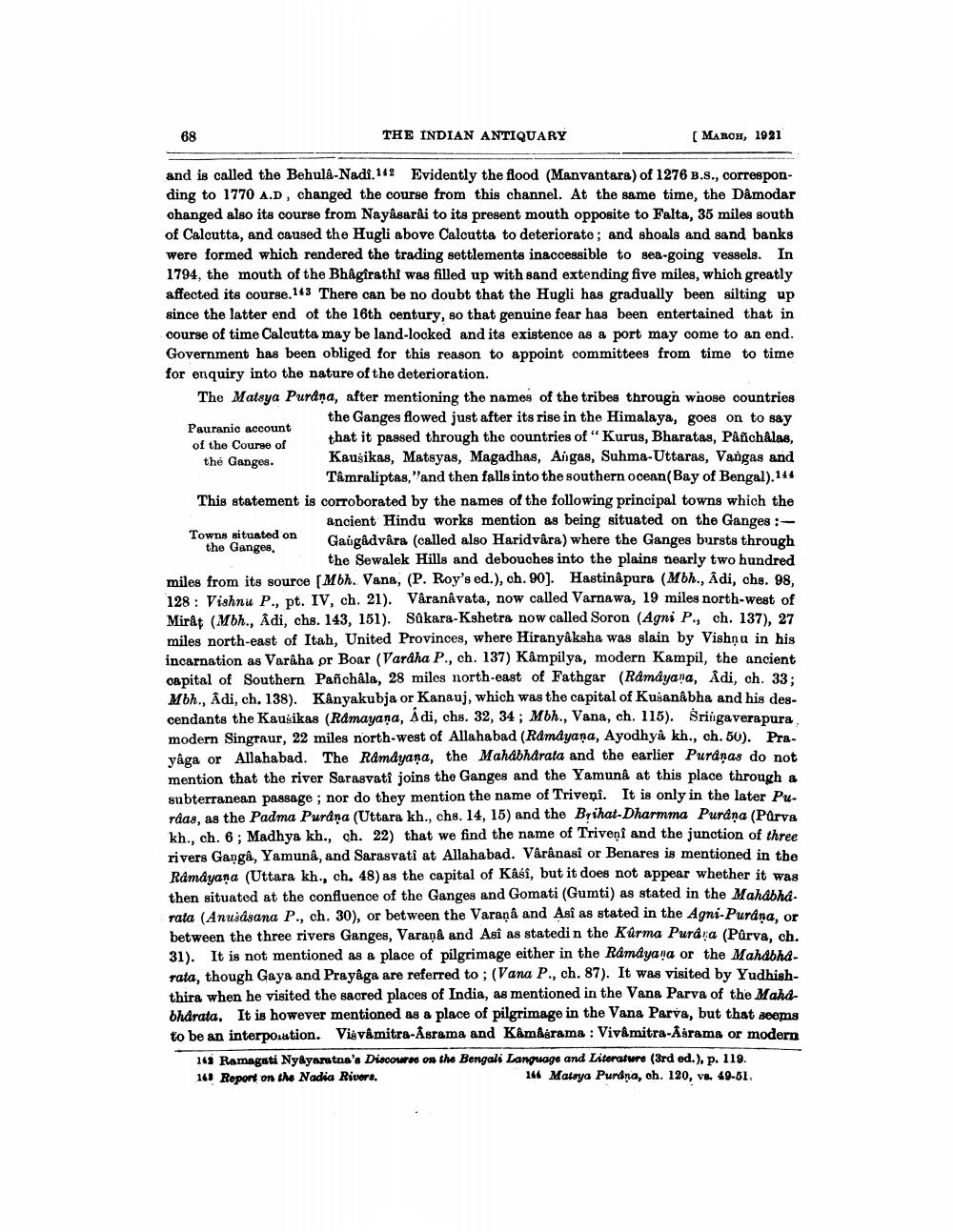________________
88
THE INDIAN ANTIQUARY
( MABCH, 1921
and is called the Behuld-Nadi,142 Evidently the flood (Manvantara) of 1276 B.s., corresponding to 1770 A.D, changed the course from this channel. At the same time, the Dâmodar changed also its course from Nayåsardi to its present mouth opposite to Falta, 35 miles south of Calcutta, and caused the Hugli above Calcutta to deteriorato; and shoals and sand banks were formed which rendered the trading settlements inaccessible to gea-going vessels. In 1794, the mouth of the Bhagirathi was filled up with sand extending five miles, which greatly affected its course.143 There can be no doubt that the Hugli has gradually been silting up since the latter end of the 16th century, so that genuine fear has been entertained that in course of time Calcutta may be land-locked and its existence as a port may come to an end. Government has been obliged for this reason to appoint committees from time to time for enquiry into the nature of the deterioration. The Matsya Purdņa, after mentioning the names of the tribes through whose countries
the Ganges flowed just after its rise in the Himalaya, goes on to say Pauranic account
that it passed through the countries of “Kurus, Bharatas, Pafchalas, of the Course of the Ganges.
Kausikas, Matsyas, Magadhas, Aigas, Suhma-Uttaras, Vangas and
Tâmraliptas,"and then falls into the southern ocean(Bay of Bengal).144 This statement is corroborated by the names of the following principal towns which the
ancient Hindu works mention as being situated on the Ganges :Towns situated on
Gaigadvâra (called also Haridvåra) where the Ganges bursts through the Ganges,
the Sewalek Hills and debouches into the plains nearly two hundred miles from its source (Mbh. Vana, (P. Roy's ed.), ch. 90). Hastinapura (Mbh., Adi, chy. 98, 128 : Vishnu P., pt. IV, ch. 21). Våranåvata, now called Varnawa, 19 miles north-west of Mirat (Mbh., Adi, chs. 143, 151). Sakara-Kshetra now called Soron (Agni P., ch. 137), 27 miles north-east of Itah, United Provinces, where Hiranyâksha was slain by Vishnu in his incarnation as Varaha pr Boar (Vardha P., ch. 137) Kâmpilya, modern Kampil, the ancient capital of Southern Pañchåla, 28 miles north-east of Fathgar (Ramdyana, Adi, ch. 33: Mbh., Adi, ch. 138). Kanyakubja or Kanauj, which was the capital of Kusanâbha and his descendants the Kausikas (Ramayana, Adi, chs. 32, 34; Mbh., Vana, ch. 115). Sringaverapura modern Singraur, 22 miles north-west of Allahabad (Ramayana, Ayodhyâ kh., ch.50). Prayaga or Allahabad. The Ramdyana, the Mahabharata and the earlier Puranas do not mention that the river Sarasvati joins the Ganges and the Yamuna at this place through a subterranean passage ; nor do they mention the name of Triveni. It is only in the later Purâas, as the Padma Purana (Uttara kh., chs. 14, 15) and the Brihat-Dharmma Purana (Parva kh., ch. 6; Madhya kh., ch. 22) that we find the name of Triveni and the junction of three rivers Ganga, Yamuna, and Sarasvati at Allahabad. Vârânasî or Benares is mentioned in the Ramayana (Uttara kh., ch. 48) as the capital of Kasi, but it does not appear whether it was then situated at the confluence of the Ganges and Gomati (Gumti) as stated in the Mahabha. rata (Anusdsana P., ch. 30), or between the Varaņå and Asî as stated in the Agni-Purana, or between the three rivers Ganges, Varana and Asî as statedi n the Kurma Purara (Parva, ch. 31). It is not mentioned as a place of pilgrimage either in the Ramayana or the Mahabharata, though Gaya and Prayaga are referred to ;(Vana P., ch. 87). It was visited by Yudhishthira when he visited the sacred places of India, as mentioned in the Vana Parva of the Mahabharata. It is however mentioned as a place of pilgrimage in the Vana Parva, but that seems to be an interpolation. Visvamitra-Asrama and Kam&srama : Vivamitra-Asrama or modern
141 Ramagati Nykyaratna's Discourse of the Bengali Language and Literature (3rd ed.), p. 119. 14. Report on the Nadia Rivera.
246 Matsya Purdna, ch. 120, ve. 49-51.




